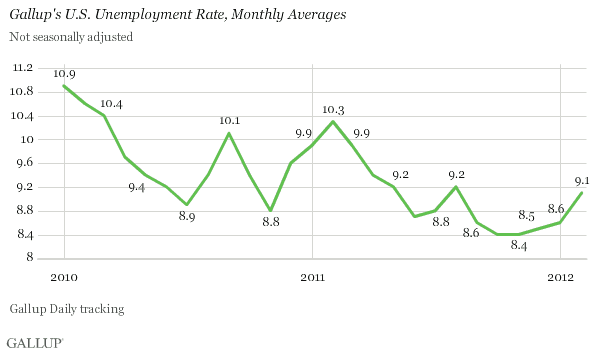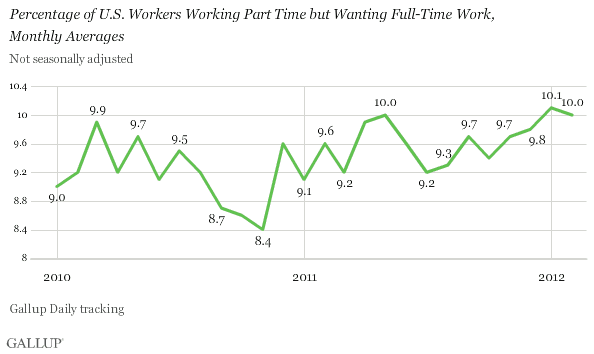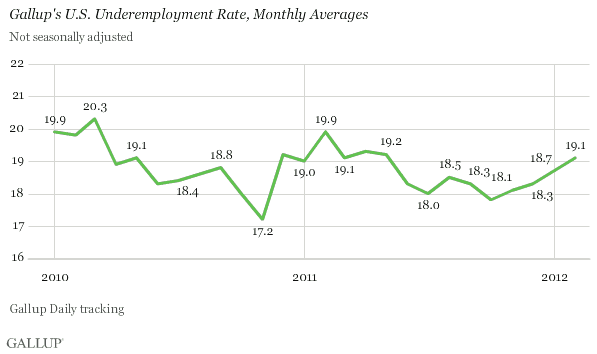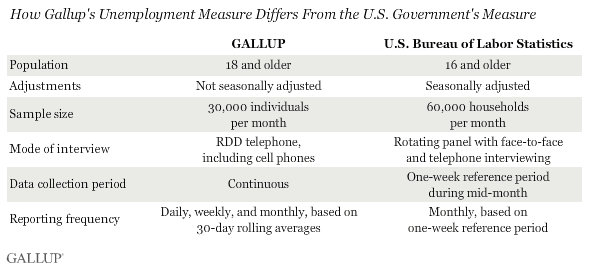Wreckovery
Gallup:
U.S. Unemployment Up in February
Underemployment is 19.1%, up from 18.7% in January
by Dennis Jacobe, Chief Economist
PRINCETON, NJ -- U.S. unemployment, as measured by Gallup without seasonal adjustment, increased to 9.1% in February from 8.6% in January and 8.5% in December.

The 0.5-percentage-point increase in February compared with January is the largest such month-to-month change Gallup has recorded in its not-seasonally adjusted measure since December 2010, when the rate rose 0.8 points to 9.6% from 8.8% in November. A year ago, Gallup recorded a February increase of 0.4 percentage points, to 10.3% from 9.9% in January 2011.
In addition to the 9.1% of U.S. workers who are unemployed, 10.0% are working part time but want full-time work. This percentage is similar to the 10.1% in January, but is higher than the 9.6% of February 2011.

As a result, Gallup's U.S. underemployment measure, which combines the percentage of workers who are unemployed and the percentage working part time but wanting full-time work, increased to 19.1% in February from 18.7% in January. This is an improvement from the 19.9% of February 2011.

Looking Ahead to the Government's Unemployment Report
The February unemployment rate the U.S. government reports on Friday morning will be based largely on mid-month conditions. In mid-February, Gallup reported that its U.S. unemployment rate had increased to 9.0% from 8.3% in mid-January. The mid-month reading normally provides a relatively good estimate of the government's unadjusted unemployment rate for the month.
Assuming the government's unadjusted rate increases -- from its 8.8% in January -- to at least match Gallup's mid-month measurement for February, then the government should also report an increase in the seasonally adjusted unemployment rate for February. If the government's unadjusted unemployment rate increases to the degree that Gallup's has from mid-month to mid-month, then the government's seasonally adjusted unemployment rate could show an even larger increase.
However, the extent of the seasonal adjustment also makes a difference. Last February, the U.S. Bureau of Labor Statistics applied a seasonal adjustment factor of 0.5 points to its unadjusted unemployment rate for the month. If that same seasonal adjustment is applied to Gallup's mid-month unemployment rate of 9.0%, it would produce a seasonally adjusted unemployment rate of 8.5%. Alternatively, if it was applied to Gallup's full-month unemployment rate of 9.1%, it would produce a seasonally adjusted rate of 8.6%. Gallup therefore forecasts an increase in the unemployment rate.
Gallup in February also found a decline in its Job Creation Index, which tends to support an increase in the February unemployment rate.
The consensus forecast, however, is for no change in the government's unemployment rate. February jobless claims were running at roughly 350,000 during the month, implying a relatively stable unemployment rate. Additionally, Wednesday's ADP report suggesting that private-sector jobs increased by more than 200,000 in February is also somewhat supportive of a stable unemployment rate forecast.
Regardless of what the government reports, Gallup's unemployment and underemployment measures show a substantial deterioration since mid-January. In this context, the increase in unemployment as measured by Gallup may, at least partly, reflect growth in the workforce, as more Americans who had given up looking for work become slightly more optimistic and start looking for work again. So while there may be positive signs, the reality Gallup finds is that more Americans are looking for work now than were doing so just six weeks ago.

Gallup.com reports
 You know. . .
You know. . .- More Lies, Damned Lies, And Statistics
In the continuing series of lies and misrepresentations from our gov't, BLS and the media I give you today's unemployment report... CNBC: US added 295,000 jobs in Feb vs. 240,000 est; unemployment rate at 5.5% vs. 5.6% est Job creation boomed...
- Gallup: Unemployment Rate Has Jumped From 7.7% To 8.9% Over Last 30 Days
Breitbart: Outside of the federal government’s Bureau of Labor statistics, the Gallup polling organization also tracks the nation’s unemployment rate. While the BLS and Gallup findings might not always perfectly align, the trends almost always do...
- Wreckovery! Hype & Change!
Breitbart: Gallup: Unemployment Rate Jumps from 7.7% to 8.9% In 30 Days Outside of the federal government's Bureau of Labor statistics, the Gallup polling organization also tracks the nation's unemployment rate. While the BLS and Gallup findings...
-
NRO: Jobs Report Shows Continuing Pain For Young Americans By Kristen Soltis This May, thousands of young Americans walked across the stage at their graduations, collected their hard-earned (and likely expensive) degrees, and promptly moved their belongings...
- No Depression
New CBO Report Decimates 'Obamanomics': Real Unemployment Hits 15% “The rate of unemployment in the United States has exceeded 8 percent since February 2009, making the past three years the longest stretch of high unemployment in this country...
